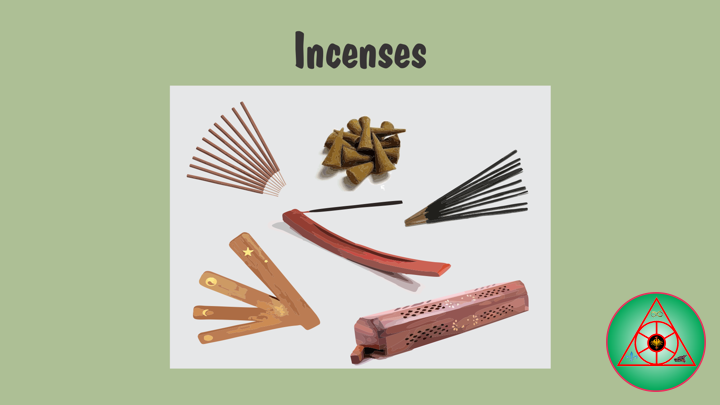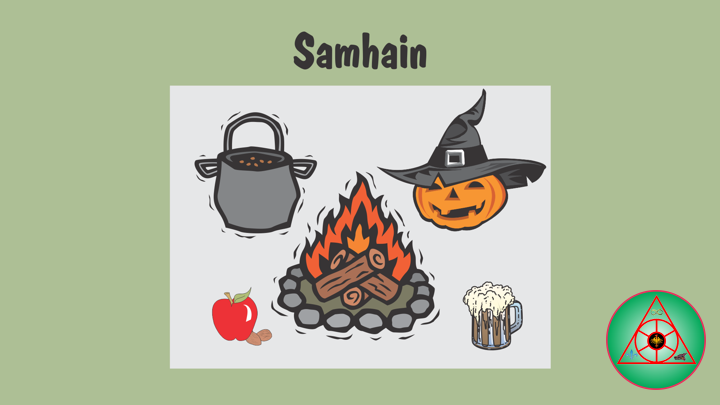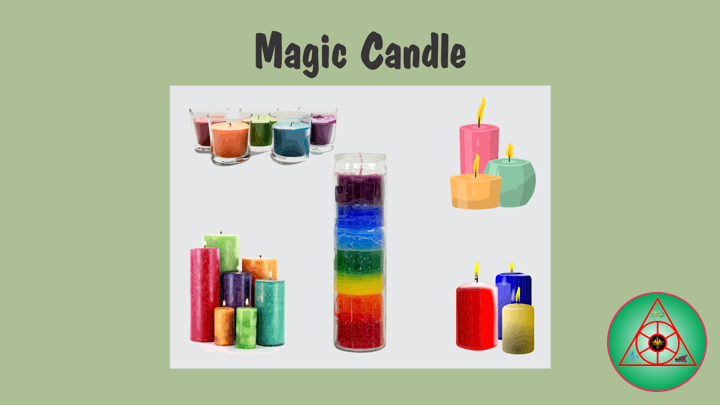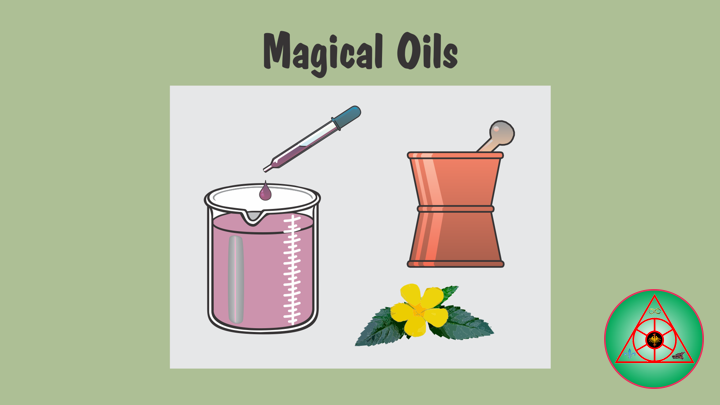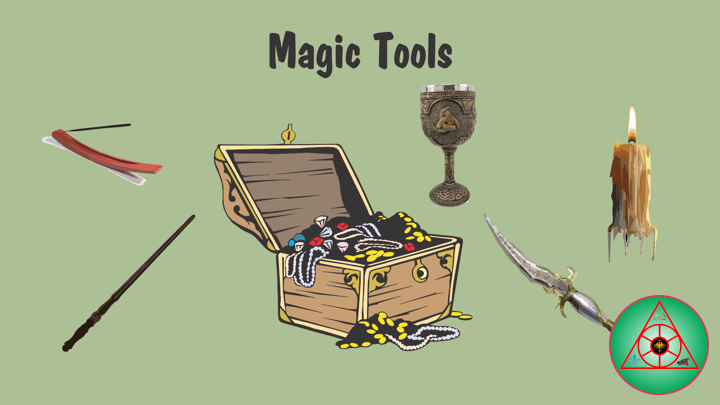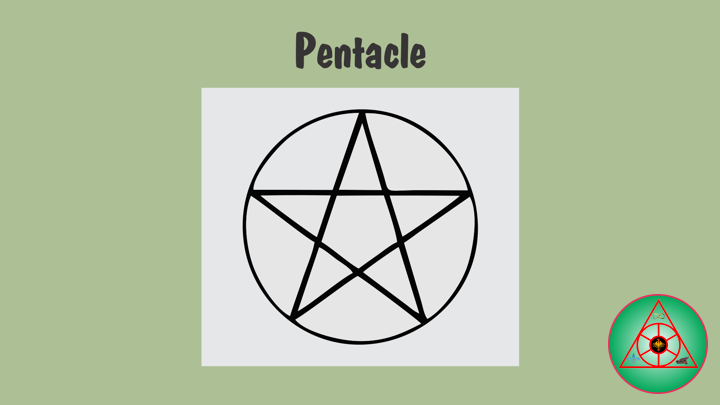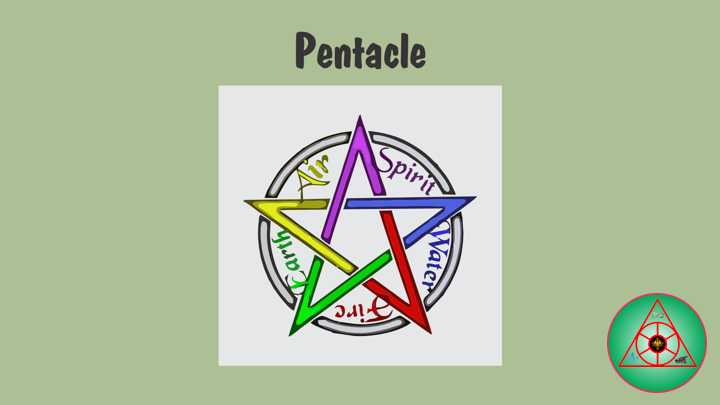Magical Tools
Magical Tools
——
#Magic #TLBWB #HighPriest #Witchcraft #Wizard #Witch #BookOfShadows #WheelOfTheYear #MagicalHerbs #MagicalOils #Incense #Pentacle #MagicCircle #MagicSpell #Grimoires
——
——
Incenses
Incense is an aromatic biotic material that releases fragrant smoke when burned. The term is used for either the material or the aroma. Incense is used for aesthetic reasons, aromatherapy, meditation, and ceremony. Incense is composed of aromatic plant materials, often combined with essential oils.
Direct-burning incense is lit directly by a flame and then blown out; leaving a glowing ember that smolders and releases a smoky fragrance. Direct-burning incense is either a paste formed around a bamboo stick, or a paste that is extruded into a stick or cone shape.
Combustible bouquets were used by the ancient Egyptians, who employed incense in both pragmatic and mystical capacities. The purpose of the usage of incense stick varies; some human beings use it for the duration of meditation and rituals.
From the dawn of times, incense has always been widely used throughout the world as it represented an essential element for religious rituals and spiritual practices in general.
But spiritualism aside, the reason why incense is still now a big thing is that apparently it also has great beneficial effects: its smell can indeed significantly change the air and therefore the energy of our environment and for this reason, we might want to be extra careful when searching for the right one for our purposes.
From the dawn of times, incense has always been widely used throughout the world as it represented an essential element for religious rituals and spiritual practices in general.
This is by far the most common one: as we said, this type of incense can be directly ignited, and as soon as the flame is extinguished it generates a light smoke, diffusing a pleasant fragrance into the air. Each stick has a specific burning time that may vary according to its form and ingredients. As a general rule, a stick of incense should usually last between 50 and 90 minutes.
Direct Burning Incense
Moreover, some examples of direct burning incense include:
- Sticks
- Coil incense
- Incense cones
- Powders
Burning incense is not simply part of a millenary tradition, but it’s indeed a fantastic way to enrich, cleansing the air around us, gifting us with gentle, mystic notes of pure delight.
Follow Us
Languages Spoken and Written: English, French and Spanish.
eMail: lostbeardedwhite@sassquatch.org
Facebook: https://www.facebook.com/neosteam.labs.9/
YouTube: https://www.youtube.com/channel/UC5eRjrGn1CqkkGfZy0jxEdA
Twitter: https://twitter.com/labs_steam
Pinterest: https://www.pinterest.com/NeoSteamLabs/
Instagram: https://www.instagram.com/luc.paquin/
The Lost Bearded White Brother
——
#Magic #TLBWB #HighPriest #Witchcraft #Wizard #Witch #Samhain #BookOfShadows #WheelOfTheYear #MagicalHerbs #MagicalOils #Incense #Pentacle #MagicCircle #MagicSpell #Grimoires
——
——
Samhain
Samhain is a Witchcraft religious festival originating from an ancient Celtic spiritual tradition. In modern times, Samhain is usually celebrated from October 31 to November 1 to welcome in the harvest and usher in “The Dark Half Of The Year”. Celebrants believe that the barriers between the physical world and the spirit world break down during Samhain, allowing more interaction between humans and denizens of the Otherworld.
Samhain is one of the major festivals of the Wheel of the Year, for many Witchcraft the most important festival of all. It is the third and final harvest festival of nuts and berries and a fire festival. All the harvest is in, all is complete, it is the end of the cycle of birth and growth, it is the point of death. The seeds of the harvest have fallen deep into the dark earth, they are unseen, dormant, and thus apparently lifeless.
Ancient Celts marked Samhain as the most significant of the four quarterly fire festivals, taking place at the midpoint between the Mabon and the Yule. During this time of year, hearth fires in family homes were left to burn out while the harvest was gathered. After the harvest work was complete, celebrants joined with High Priest to light a community fire using a wheel that would cause friction and spark flames. The wheel was considered a representation of the sun and used along with prayers. Cattle were sacrificed, and participants took a flame from the communal bonfire back to their home to relight the hearth.
The God, as Sun King is sacrificed back to the land with the seed until the Yule, and the Goddess, now as Crone, mourns Him until His rebirth at Yule. He travels the Underworld learning its wisdom. This is the time of the descent into darkness, of pre-conception, out of which new life, new ideas, will eventually emerge. Traditionally the veils between the worlds are at their thinnest now. Boundaries dissolve and all is laid bare. It is time to honour and offer hospitality to, our ancestors.
At Samhain the dark half of the year commences. It is a truly magical time. Death is always followed by rebirth and while this is the end of the old year, it is the beginning of the new year. For the Celts the day did not begin at dawn, it began at sunset, it began with darkness. Light is always born out of darkness, they are inseparable, interdependent, and necessary. Darkness is fertile with “All Potential”. With the beginning of this dark phase comes the opportunity to rest and reflect on the past and to dream of new beginnings. The seed now hidden in the earth will germinate in its season. Look for the seeds in yourself.
Honouring The Ancestors
Honouring your ancestors is a very special thing to do at this time and can be done in many simple ways. Think about all those departed souls from your life, both family and friends, children may wish to remember pets even, place photographs of them on your altar. Offer them your hospitality, welcome their presence into your home. At your Samhain festival, consider laying an extra place for them to join you at the table, cook and eat their favourite dishes, talk about them, remember them, bring them closer. You and your children can make an offering for departed pets by leaving some dog food outside on Halloween night, many night creatures appreciate this offering. Be careful what you put outside, we used to put out bread and milk.
Follow Us
Languages Spoken and Written: English, French and Spanish.
eMail: lostbeardedwhite@sassquatch.org
Facebook: https://www.facebook.com/neosteam.labs.9/
YouTube: https://www.youtube.com/channel/UC5eRjrGn1CqkkGfZy0jxEdA
Twitter: https://twitter.com/labs_steam
Pinterest: https://www.pinterest.com/NeoSteamLabs/
Instagram: https://www.instagram.com/luc.paquin/
The Lost Bearded White Brother
——
#Magic #TLBWB #HighPriest #Witchcraft #Wizard #Witch #MagicCandle #BookOfShadows #WheelOfTheYear #MagicalHerbs #MagicalOils #Incense #Pentacle #MagicCircle #MagicSpell #Grimoires
——
——
Candle
A candle is a solid block of wax with an embedded ignitable wick that provides light, and in some cases, a fragrance. It can also be used to provide heat, or as a method of keeping time.
For a candle to burn, a heat source, commonly a naked flame, is used to light the candle’s wick, which melts and vaporizes a small amount of fuel the wax. Once vaporized, the fuel combines with oxygen in the atmosphere to ignite and form a constant flame. This flame provides sufficient heat to keep the candle burning via a self-sustaining chain of events: the heat of the flame melts the top of the mass of solid fuel, the liquefied fuel then moves upward through the wick via capillary action, the liquefied fuel finally vaporizes to burn within the candle’s flame.
As the mass of solid fuel is melted and consumed, the candle becomes shorter. Portions of the wick that are not emitting vaporized fuel are consumed in the flame. The incineration of the wick limits the exposed length of the wick, thus maintaining a constant burning temperature and rate of fuel consumption. In modern candles, the wick is constructed so that it curves over as it burns. This ensures that the end of the wick gets oxygen and is then consumed by fire, a self-trimming wick.
Magic Candle
In Witchcraft and related forms of the candle is frequently used on the altar to represent the presence of the God and Goddess, and in the four corners of a ritual circle to represent the presence of the four classical elements: Fire, Earth, Air, and Water. When used in this manner, lighting and extinguishing the candle marks the opening and closing of the ritual. The candle is also frequently used for magical meditative purposes. Altar candles are traditionally thick tall candles or long tapers which are available in many colors. In Witchcraft, the candles that are used come in a variety of colors, depending on the nature of the ritual or custom at hand. Some Witchcraft may use red, green, blue, yellow and white or purple candles to represent the elements.
Using candles in magic based on Witchcraft beliefs is known as “Sympathetic Magic” in that it is believed the candle represents the outcome the person is wanting. It is a “Like Attracts Like” form of magical practice. For example, if a person is looking for a job or needs extra income a green candle would be used. For romance, a red candle would be used red is a universal color of love and hearts. There is an additional belief that the smoke from the candles will take the prayer requests, desires, or wishes up to the gods.
If you’re just starting to explore Witchcraft, you’ve gotta “Let It Burn”. Candles are a staple item in any magical tool kit. They’re used to amplify and release energy, and they can either be left unlit around your pad to promote positive vibes or used lit in rituals and spells.
Magic Candle is driven by the element of fire, which represents transformation. Fire changes everything it interacts with, whether it’s turning a love letter into ashes. This transformational energy is what you’re channeling in Magic Candle, encouraging and accelerating changes in your life.
The act of burning is believed to connect the physical world to the spiritual realm, but the other key element here is about using different candle colors. This is called color magic. Different colors store different types of energy, and this is what we’re trying to access when we burn a candle of that color. Burning candles is an easy way to access that color’s energy, but it’s not the only way.
Follow Us
Languages Spoken and Written: English, French and Spanish.
eMail: lostbeardedwhite@sassquatch.org
Facebook: https://www.facebook.com/neosteam.labs.9/
YouTube: https://www.youtube.com/channel/UC5eRjrGn1CqkkGfZy0jxEdA
Twitter: https://twitter.com/labs_steam
Pinterest: https://www.pinterest.com/NeoSteamLabs/
Instagram: https://www.instagram.com/luc.paquin/
The Lost Bearded White Brother
——
#Magic #TLBWB #HighPriest #Witchcraft #Wizard #Witch #BookOfShadows #WheelOfTheYear #MagicalHerbs #MagicalOils #Incense #Pentacle #MagicCircle #MagicSpell #Grimoires
——
——
Magical Oils
Magical Oils plants in the form of oil and incense were elements of religious and therapeutic practices in early cultures worldwide. In addition, anointment with perfumes and fragrant oils was an almost universal practice. In some folk magic traditions, Witchcraft Magical Oils can be used for both anointing people and objects, such as candles. In some magical systems, such as various forms of Witchcraft, candle dressing oils are also used to anoint the skin, so many oils are blended in a way that is skin-safe. This way, they can be used for dressing candles and charms, but also can be worn on your body.
Using an eyedropper, add the Magical Oils in the recipes. Be sure to follow the recommended proportions. Swish the Magical Oils into the base oil by swirling in a clockwise direction. Finally, consecrate your oils if your tradition requires it. Make sure you store your oil blends in a place away from heat and moisture. Keep them in dark-colored glass bottles, and be sure to label them for use. Write the date on the label, and use within six months.
There are a number of ways you can use your oils in a ritual setting. They are often rubbed on candles for use in spellwork, this blends the powerful energies of the oil with the magical symbolism of the candle’s color and the energy of the flame itself.
Magical Oils are used to anoint the body. If you are blending an oil to use for this purpose, be sure that you’re not including any ingredients that are irritating to the skin. Oils applied to the body bring the wearer the energies of the oil. Finally, crystals, amulets, talismans and other charms may be anointed with the Magical Oils of your choice. This is a great way to turn a simple mundane item into an item of magical power and energy.
A good place to start is with 8 ounces oil per 8 tablespoons herb or flower. Remember a little oil goes a long way. You can use Mineral Oil or some other neutral carrier oil to absorb the scent and properties of the herb. It is helpful to visualize the purpose for which you are making the oil throughout the process or you can say a little chant pertaining to that certain oil while making it to add more of your energy and power to it. It is important that you cap the jars tightly or you will have moldy mixtures. Remember the darker the bottle, the better your oil will keep. Add tincture of benzoin to preserve your oils.
Pour your oil into your mortar. Add your herb a little at a time, pressing it into the oil with your pestle. After you have combined it well, pour it into a bottle. Store the bottle in a dark, consecrated place for three days. On the fourth day check oil to see if it has absorbed enough of the scent.
You can repeat this process of scenting your oil until its as strong as you desire. When the scent is right for you it is ready for use in your spellwork. Strain with cheesecloth, store in tightly capped dark glass bottles with a little tincture of benzoin to preserve.
Follow Us
Languages Spoken and Written: English, French and Spanish.
eMail: lostbeardedwhite@sassquatch.org
Facebook: https://www.facebook.com/neosteam.labs.9/
YouTube: https://www.youtube.com/channel/UC5eRjrGn1CqkkGfZy0jxEdA
Twitter: https://twitter.com/labs_steam
Pinterest: https://www.pinterest.com/NeoSteamLabs/
Instagram: https://www.instagram.com/luc.paquin/
The Lost Bearded White Brother
——
#Magic #TLBWB #HighPriest #Witchcraft #Wizard #Witch #BookOfShadows #WheelOfTheYear #SacredHerbs #MagicalOils #Incense #Pentacle #MagicCircle #Spell #Grimoires
——
——
Magic Tools
Witchcraft Wood Box
Box help keep your Witchcraft stuff organized and tucked away from prying eyes. Our use them to hold altar cloth, athame, wand, chalices, candles, bell, bowl, mortar and pestle, incense burners, incense, book of shadows, crystals, herbs, etc…
Altar Table
Create a beautiful focal point for your Witchcraft with our altar table. Altar table are an excellent resource for helping people focus. You can place objects on them that help with your Witchcraft practice. Perfect for small homes on the go, this beautiful altar table can turn almost any space into your sacred space.
Altar Cloth
An altar cloth helps transform ordinary space into sacred space.
Athame
Essential tools of the Witchcraft’s altar. We have ritual knives fitting style.
Wand
A primal symbol of the Wizard or Witch will, wand are used to direct energy and cast boundaries. Unique and handmade Witchcraft wand.
Chalices
A chalice is a footed cup intended to hold a drink. In Witchcraft practice, a chalice is often used for drinking during a ceremony.
Candles
Candles, candle holders, and accessories. Find the tools for your candle Witchcraft.
Bell
Wizard or Witch can’t resist the merry sound of bells and chimes.
Witchcraft Hanheld Mirror
These Witchcraft handheld mirrors are a must have.
Small Wood Or Ceramic Bowl
A small bowl that’s perfect for rings, offerings, or small quantities of herbs and salts.
Sea Salt
A versatile ingredient for cleansing and spellwork, salt belongs on every Witchcraft altar and herb cabinet. These natural air-dried salt crystals have grain that’s easy to use for your Witchcraft work.
Mortar And Pestle
The mortar and pestle is both a powerful Witchcraft symbol and a practical item for grinding herbs and incenses. It is one of the essential tools of the Wizard or Witch altar.
Incense Burners
An essential accessory for using incense and resin safely, without fear of ash dropping in unwanted places, is an incense holder or burner.
Charcoal Tablets
These charcoal tablets. The coating sparks across the charcoal surface and then should be left for a few minutes until it has started to heat through. These tablets are fast lighting, smoke-free, odorless, tasteless and long burning and means they shouldn’t interfere with the scent of the incense.
Incense
Incense is aromatic biotic material that releases fragrant smoke when burnt. The term is used for either the material or the aroma.
Herb And Herb Oil
Herb and herb oils are a time-honored ingredient in Witchcraft practice. Here you’ll find anointing oils to empower your spellwork or sweeten your environment.
Essential Oils
When only the purest will do. Essential oils are a way to add highly concentrated plant essences to your homemade formulas.
Crystals, Gemstones, Pendulum, Book of Shadows, Etc…
Follow Us
Languages Spoken and Written: French, English and Spanish.
eMail: lostbeardedwhite@sassquatch.org
Facebook: https://www.facebook.com/neosteam.labs.9/
YouTube: https://www.youtube.com/channel/UC5eRjrGn1CqkkGfZy0jxEdA
Twitter: https://twitter.com/labs_steam
Pinterest: https://www.pinterest.com/NeoSteamLabs/
Instagram: https://www.instagram.com/luc.paquin/
The Lost Bearded White Brother
——
#Magic #TLBWB #HighPriest #Witchcraft #Wizard #Witch #WheelOfTheYear #SacredHerbs #MagicalOils #Incense #Pentacle #MagicCircle #Spell #Grimoires
——
—–
——
Pentacle
Witchcraft is considered a modern interpretation of pre-Christian traditions, though some involved claim a direct line to ancient practices. It may be practiced by individuals or members of groups. There is great diversity among individuals and groups that practice a Witchcraft religion, but many are duotheistic, worshiping both a Mother Goddess and a Horned God.
A pentacle is a kind of amulet or talisman used in traditional magical evocations and in some magical traditions such as Witchcraft, alongside other magical tools. It is often confused with the pentagram symbol, which is also widely used within the words are often used.
A pentacle is employed as a magical tool within modern forms of witchcraft, generally to summon certain energies or command spirits. It is one of the four elemental tools of witchcraft, along with the chalice, the athame and the wand, and represents the element of Earth. It is normally the centrepiece of the altar on which objects are to be consecrated or charged, and such things as amulets, charms and other tools are placed on it, as may also be the salt and water for blessing. It may also be worn around the neck, or just placed within the triangle of evocation.
A pentacle is generally a disc made of parchment, paper, metal, although it can be of other materials such as stone, clay, wood, etc, on which the symbol of a spirit or energy being evoked is drawn. Other protective symbols may also be included, and the pentacle can be decorated and personalized by the individual, according to its required purpose.
Despite the sound of the word, pentacle often had no connotation of five in the old magical texts. A pentacle could therefore be any magical talisman inscribed with any symbol or character, and a great variety of shapes and images appear in the old magical grimoires. When they do incorporate star-shaped figures, than pentagrams five-pointed.
On the other hand usually inscribed inside a circle, is also used widely today as a symbol of faith by many Witchcraft. Many people who practice Witchcraft faiths wear jewellery incorporating the pentagram symbol, the points of which are held to represent earth, air, fire, water and spirit. The Witchcraft pentagram is drawn upright, single point on top.
According to the ancient grimoires, the pentacle is of central importance in the evocation of spirits. A fairly typical evocation involves a series of conjurations of increasing potency, each involving the display of the pentacle. Once the spirit has appeared and been constrained, the pentacle is covered again, but is uncovered whenever demands are made of the spirit or when it is compelled to depart.
Follow Us
Languages Spoken and Written: French, English and Spanish.
eMail: lostbeardedwhite@sassquatch.org
Facebook: https://www.facebook.com/neosteam.labs.9/
YouTube: https://www.youtube.com/channel/UC5eRjrGn1CqkkGfZy0jxEdA
Twitter: https://twitter.com/labs_steam
Pinterest: https://www.pinterest.com/NeoSteamLabs/
Instagram: https://www.instagram.com/luc.paquin/
The Lost Bearded White Brother
Samhain is considered by Wiccans to be one of the four Greater Sabbats. Samhain is considered by some as a time to celebrate the lives of those who have passed on, and it often involves paying respect to ancestors, family members, elders of the faith, friends, pets, and other loved ones who have died. In some rituals the spirits of the departed are invited to attend the festivities. It is seen as a festival of darkness, which is balanced at the opposite point of the wheel by the festival of Beltane, which is celebrated as a festival of light and fertility.
Many Pagans believe that at Samhain the veil between this world and the afterlife is at its thinnest point of the whole year, making it easier to communicate with those who have left this world.
Wheel of the Year
Samhain is a Gaelic festival marking the end of the harvest season and the beginning of winter or the “darker half” of the year. Traditionally, Samhain is celebrated from sunset on 31 October to sunset on 1 November, which is about halfway between the autumn equinox and the winter solstice. It is one of the four Gaelic seasonal festivals, along with Imbolc, Beltane and Lughnasadh. Historically, it was widely observed throughout Ireland, Scotland and the Isle of Man. Similar festivals are held at the same time of year in other Celtic lands; for example the Brythonic Calan Gaeaf (in Wales), Kalan Gwav (in Cornwall), and Kalan Goañv (in Brittany).
Samhain is believed to have pagan origins and there is evidence it has been an important date since ancient times. The Mound of the Hostages, a Neolithic passage tomb at the Hill of Tara, is aligned with the Samhain sunrise. It is mentioned in some of the earliest Irish literature and many important events in Irish mythology happen or begin on Samhain. It was the time when cattle were brought back down from the summer pastures and when livestock were slaughtered for the winter. As at Beltane, special bonfires were lit. These were deemed to have protective and cleansing powers and there were rituals involving them. Like Beltane, Samhain was seen as a liminal time, when the boundary between this world and the Otherworld could more easily be crossed. This meant the Aos Sí, the ‘spirits’ or ‘fairies’, could more easily come into our world. Most scholars see the Aos Sí as remnants of the pagan gods and nature spirits. At Samhain, it was believed that the Aos Sí needed to be propitiated to ensure that the people and their livestock survived the winter. Offerings of food and drink were left outside for them. The souls of the dead were also thought to revisit their homes seeking hospitality. Feasts were had, at which the souls of dead kin were beckoned to attend and a place set at the table for them. Mumming and guising were part of the festival, and involved people going door-to-door in costume (or in disguise), often reciting verses in exchange for food. The costumes may have been a way of imitating, and disguising oneself from, the Aos Sí. Divination rituals and games were also a big part of the festival and often involved nuts and apples. In the late 19th century, Sir John Rhys and Sir James Frazer suggested that it was the “Celtic New Year”, and this view has been repeated by some other scholars.
In the 9th century AD, Western Christianity shifted the date of All Saints’ Day to 1 November, while 2 November later became All Souls’ Day. Over time, Samhain and All Saints’/All Souls’ merged to create the modern Halloween. Historians have used the name ‘Samhain’ to refer to Gaelic ‘Halloween’ customs up until the 19th century.
Etymology
In Modern Irish the name is Samhain, in Scottish Gaelic Samhainn/Samhuinn, and in Manx Gaelic Sauin. These are also the names of November in each language, shortened from Mí na Samhna (Irish), Mì na Samhna (Scottish Gaelic) and Mee Houney (Manx). The night of 31 October (Halloween) is Oíche Shamhna (Irish), Oidhche Shamhna (Scottish Gaelic) and Oie Houney (Manx), all meaning “Samhain night”. 1 November, or the whole festival, may be called Lá Samhna (Irish), Là Samhna (Scottish Gaelic) and Laa Houney (Manx), all meaning “Samhain day”.
These names all come from the Old Irish samain, samuin or samfuin all referring to 1 November (latha na samna: ‘samhain day’), and the festival and royal assembly held on that date in medieval Ireland (oenaig na samna: ‘samhain assembly’). Its meaning is glossed as ‘summer’s end’, and the frequent spelling with f suggests analysis by popular etymology as sam (‘summer’) and fuin (‘end’). The Old Irish sam is from Proto-Indo-European (PIE) *semo-; cognates include Welsh haf, Breton hañv, English summer and Old Norse sumar, all meaning ‘summer’, and the Sanskrit sáma (‘season’).
In 1907, Whitley Stokes suggested an etymology from Proto-Celtic *samani (‘assembly’), cognate to Sanskrit sámana, and Gothic samana. J. Vendryes concludes that samain is unrelated to *semo- (‘summer’), remarking that the Celtic ‘end of summer’ was in July, not November, as evidenced by Welsh gorffennaf (‘July’). We would therefore be dealing with an Insular Celtic word for ‘assembly’, *samani or *samoni, and a word for ‘summer’, saminos (from *samo-: ‘summer’) alongside samrad, *samo-roto-.
Neopaganism
Samhain and Samhain-based festivals are held by some Neopagans. As there are many kinds of Neopaganism, their Samhain celebrations can be very different despite the shared name. Some try to emulate the historic festival as much as possible. Other Neopagans base their celebrations on sundry unrelated sources, Gaelic culture being only one of the sources. Folklorist Jenny Butler describes how Irish pagans pick some elements of historic Samhain celebrations and meld them with references to the Celtic past, making a new festival of Samhain that is inimitably part of neo-pagan culture.
Wicca
Wiccans celebrate a variation of Samhain as one of the yearly Sabbats of the Wheel of the Year. It is deemed by most Wiccans to be the most important of the four “greater Sabbats”. Samhain is seen by some Wiccans as a time to celebrate the lives of those who have died, and it often involves paying respect to ancestors, family members, elders of the faith, friends, pets and other loved ones who have died. In some rituals the spirits of the dead are invited to attend the festivities. It is seen as a festival of darkness, which is balanced at the opposite point of the wheel by the spring festival of Beltane, which Wiccans celebrate as a festival of light and fertility.
Wiccans believe that at Samhain the veil between this world and the afterlife is at its thinnest point of the whole year, making it easier to communicate with those who have left this world.
The Lost Bearded White Brother
Russia
Witchcraft Trials
Although these two methods of torture were used in the west and the east, Russia implemented a system of fines payable for the crime of witchcraft during the seventeenth century. Thus, even though torture methods in Muscovy were on a similar level of harshness as Western European methods used, a more civil method was present. In the introduction of a collection of trial records pieced together by Russian scholar Nikolai Novombergsk, he argues that Muscovite authorities used the same degree of cruelty and harshness as Western European Catholic and Protestant countries in persecuting witches. By the mid-sixteenth century the manifestations of paganism, including witchcraft, and the black arts – astrology, fortune telling, and divination – became a serious concern to the Muscovite church and state.
Tsar Ivan IV (reigned 1547-1584) took this matter to the ecclesiastical court and was immediately advised that individuals practicing these forms of witchcraft should be excommunicated and given the death penalty. Ivan IV, as a true believer in witchcraft, was deeply convinced that sorcery accounted for the death of his wife, Anastasiia in 1560, which completely devastated and depressed him, leaving him heartbroken. Stemming from this belief, Ivan IV became majorly concerned with the threat of witchcraft harming his family, and feared he was in danger. So, during the Oprechnina (1565-1572), Ivan IV succeeded in accusing and charging a good number of boyars with witchcraft whom he did not wish to remain as nobles. Rulers after Ivan IV, specifically during the Time of Troubles (1598-1613), increased the fear of witchcraft among themselves and entire royal families, which then led to further preoccupation with the fear of prominent Muscovite witchcraft circles.
After the Time of Troubles, seventeenth-century Muscovite rulers held frequent investigations of witchcraft within their households, laying the ground, along with previous tsarist reforms, for widespread witchcraft trials throughout the Muscovite state. Between 1622 and 1700 ninety-one people were brought to trial in Muscovite courts for witchcraft. Although Russia did partake in the witch craze that swept across Western Europe, the Muscovite state did not persecute nearly as many people for witchcraft, let alone execute a number of individuals anywhere close to the number executed in the west during the witch hysteria.
The Lost Bearded White Brother
Russia
Witchcraft Trials
Witchcraft trials occurred frequently in seventeenth-century Russia, although the “great witch-hunt” is believed to be a predominately Western European phenomenon. However, as the witchcraft-trial craze swept across West European countries during this time, Orthodox Christian Eastern Europe indeed partook in this so-called “witch hysteria.” This involved the persecution of both males and females who were believed to be practicing paganism, herbology, the black art, or a form of sorcery within and/or outside their community. Very early on witchcraft legally fell under the jurisdiction of the ecclesiastical body, the church, in Kievan Rus’ and Muscovite Russia. Sources of ecclesiastical witchcraft jurisdiction date back as early as the second half of the eleventh century, one being Vladimir the Great’s first edition of his State Statute or Ustav, another being multiple references in the Primary Chronicle beginning in 1024.
The sentence for an individual found guilty of witchcraft or sorcery during this time, and in previous centuries, typically included either burning at the stake or being tested with the “ordeal of cold water” or judicium aquae frigidae. The cold-water test was primarily a Western European phenomenon, but was used as a method of truth in Russia prior to, and post, seventeenth-century witchcraft trials in Muscovy. Accused persons who drowned were considered innocent, and ecclesiastical authorities would proclaim them “brought back,” but those who floated were considered guilty of practicing witchcraft, and burned at the stake or executed in an unholy fashion. The thirteenth-century bishop of Vladimir, Serapion Vladimirskii, preached sermons throughout the Muscovite countryside, and in one particular sermon revealed that burning was the usual punishment for witchcraft, but more often the cold water test was used as a precursor to execution.
The Lost Bearded White Brother
Russia
Societal View of Witchcraft
The dominant societal concern those practicing witchcraft was not whether paganism was effective, but whether it could cause harm. Peasants in Russian and Ukrainian societies often shunned witchcraft, unless they needed help against supernatural forces. Impotence, stomach pains, barrenness, hernias, abscesses, epileptic seizures, and convulsions were all attributed to evil (or witchcraft). This is reflected in linguistics; there are numerous words for a variety of practitioners of paganism-based healers. Russian peasants referred to a witch as a chernoknizhnik (a person who plied his trade with the aid of a black book), sheptun/sheptun’ia (a “whisperer” male or female), lekar/lekarka or znakhar/znakharka (a male or female healer), or zagovornik (an incanter).
Ironically enough, there was universal reliance on folk healers – but clients often turned them in if something went wrong. According to Russian historian Valerie A. Kivelson, witchcraft accusations were normally thrown at lower-class peasants, townspeople and Cossacks. People turned to witchcraft as a means to support themselves. The ratio of male to female accusations was 75% to 25%. Males were targeted more, because witchcraft was associated with societal deviation. Because single people with no settled home could not be taxed, males typically had more power than women in their dissent.
The Lost Bearded White Brother
